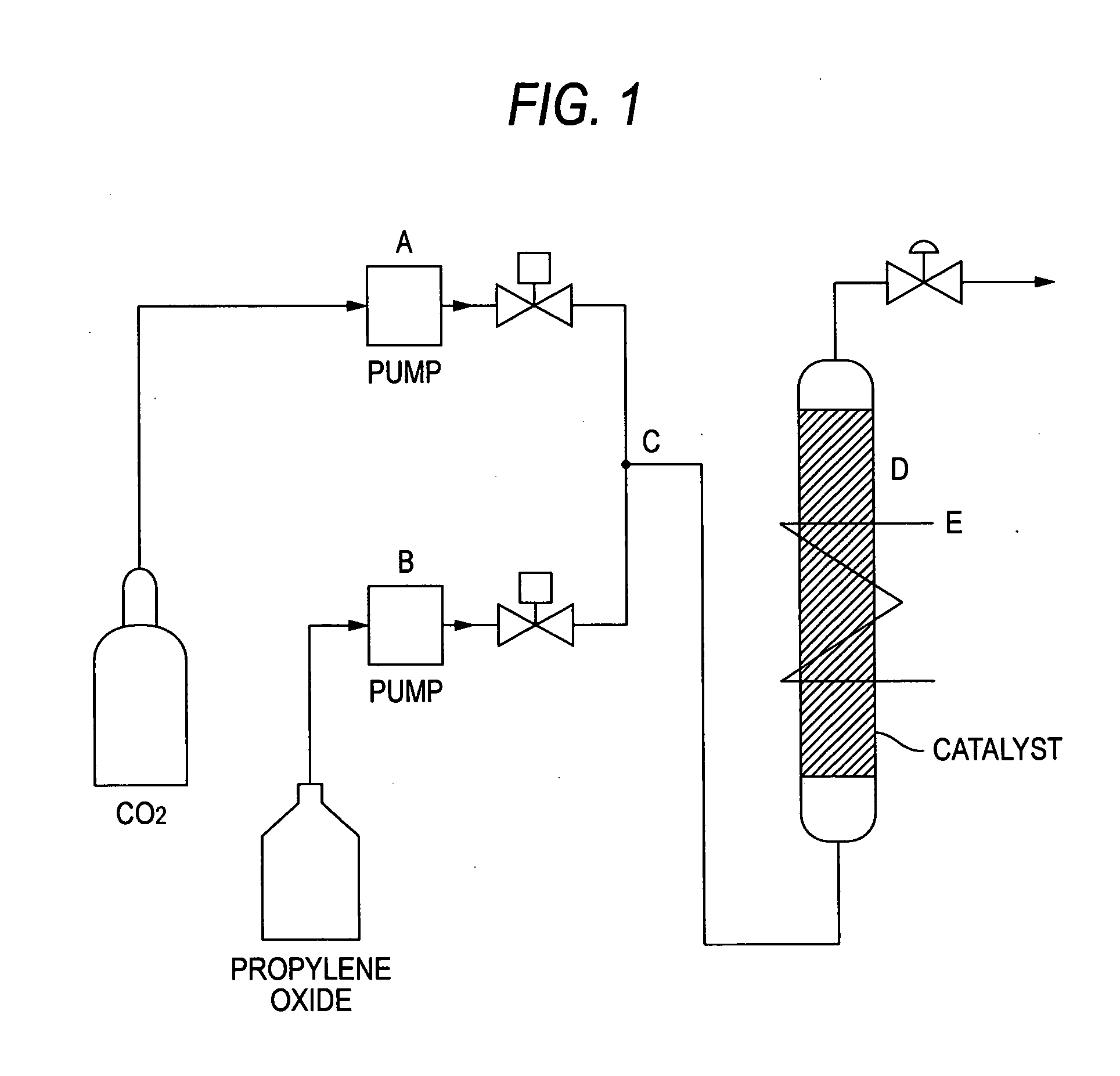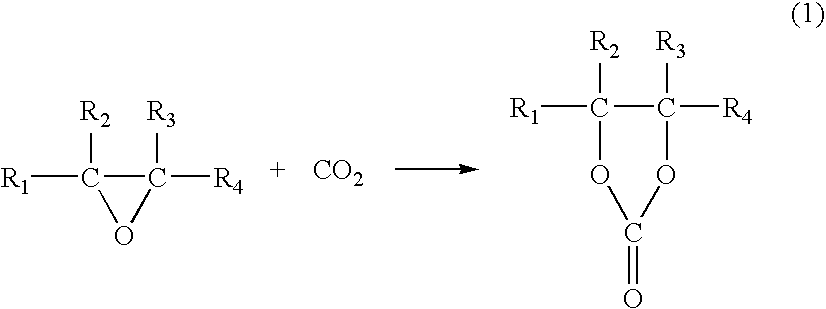Catalyst for Cyclic Carbonate Synthesis
a cyclic carbonate and catalyst technology, applied in the direction of organic compounds/hydrides/coordination complex catalysts, physical/chemical process catalysts, metal/metal-oxides/metal-hydroxide catalysts, etc., can solve the problems of degradation of catalysts or the production of side products, and many solid catalysts are generally not satisfactory, etc., to achieve high selectivity, high yield, and safe and inexpensive
- Summary
- Abstract
- Description
- Claims
- Application Information
AI Technical Summary
Benefits of technology
Problems solved by technology
Method used
Image
Examples
example 1
[0073]Silica surface-modified with a phosphonium salt was prepared according to the following method: 7.00 g of SiO2—C3H6Cl (manufactured by Aldrich, 3-chloropropyl functional group-having silica gel; amount of functional group per unit weight, 0.71 mmol / g) was suspended in 50 ml of toluene in argon, and with gradually stirring it in a 200-ml three-neck flask equipped with a stirring blade, 3.00 g of tributyl phosphine was added thereto. In an argon atmosphere, the suspension was reacted at 110° C. for 1 week, still kept stirred. The liquid was filtrated away from the suspension after the reaction, and the resulting solid was washed with methanol, acetone and ether in that order, then dried with air, and further dried in a vacuum of 1 mm or less at room temperature for 6 hours. This is used as a catalyst directly as it is. The above reaction may be schematically expressed by the following chemical reaction (7). As a result of elementary analysis thereof the product contained 0.23 mm...
example 2
[0074]As in the following chemical formula 8, silica gel surface-modified with tributylphosphonium bromide, SiO2—C3H6PBu3Br was obtained according to the same process as in the above section but starting from 3-bromopropyl functional group-having silica gel SiO2—C3H6Br (amount of functional group per unit weight, 1.43 mmol / g). The data of elementary analysis were 0.48 mmol / g of P and 0.85 mmol / g of Br.
Preparation of Catalyst Through Ion-Exchange Reaction
example 3
[0075]Silica gel surface-modified with tributylphosphonium chloride described in Example 1 was converted into a bromide through ion-exchange reaction. Concretely, a solution was prepared by dissolving sodium bromide in from 50 ml to 3000 ml, per gram of SiO2—C3H6PBu3Cl, of methanol, in an amount of from 5 times to 100 times the theoretical exchange capacity amount thereof (0.7 mmol per gram), and this was gradually applied over the catalyst particles filled in a column or on a filter. After thus treated, the catalyst was washed with methanol, then washed acetone and ethanol in that order, dried with air, transferred into a Schlenk tube, and dried in vacuum at room temperature to 100° C. to obtain SiO2—C3H6PBu3Br. The data of elementary analysis were 0.4 mmol / g of Cl, 0.36 mmol / g of Br and 0.32 mmol / g of P.
PUM
| Property | Measurement | Unit |
|---|---|---|
| mean particle size | aaaaa | aaaaa |
| boiling point | aaaaa | aaaaa |
| temperature | aaaaa | aaaaa |
Abstract
Description
Claims
Application Information
 Login to View More
Login to View More - R&D
- Intellectual Property
- Life Sciences
- Materials
- Tech Scout
- Unparalleled Data Quality
- Higher Quality Content
- 60% Fewer Hallucinations
Browse by: Latest US Patents, China's latest patents, Technical Efficacy Thesaurus, Application Domain, Technology Topic, Popular Technical Reports.
© 2025 PatSnap. All rights reserved.Legal|Privacy policy|Modern Slavery Act Transparency Statement|Sitemap|About US| Contact US: help@patsnap.com



